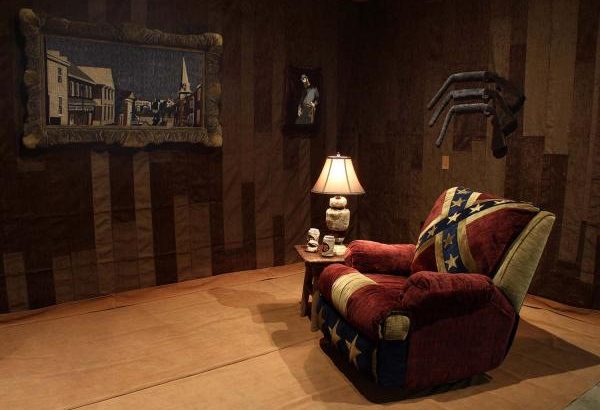If you took a moment to step out of the abrasive Michigan cold and into 202 South Thayer, you might also get the feeling you were stepping into the living room of any family in America. This is the first impression that the Institute for the Humanities’ latest exhibit provides. The space of the interior is small, homey, and inviting: a worn armchair slumps before a flickering TV, nestled atop a plush rug. The area is peaceful and dim, inviting you to sit down, take a load off, relax. However, just one more look may put you on edge; something sinister swirls around the sleepy scene, something not quite right. In an instant it hits, the glaringly obvious: the well worn chair is not upholstered with plaid, or gingham, or any fabric you’d expect, but instead, horrifyingly, with a Confederate Flag.
As I came to this realization, a strange feeling settled into my stomach. The space is a portrait of middle class America gone eerily wrong, while remaining hauntingly familiar. I believe this difficult truth is exactly what artist Valery Jung Estabrook aims to capture in her installation, titled “Hometown Hero (Chink): An American Interior.” Growing up an Asian American in Virginia, Estabrook’s work seems to reflect her desire to maintain a Southern identity while acknowledging that her home state is not a universally accepting place.
Upon closer inspection, the room only becomes more unsettling. It is beautifully crafted, hand sewn by Estabrook in chenille. Everything is plush, down to the crumpled beer cans, and the rifles limply mounted to the wall. This choice in medium suggests the space as something tied down, as if the room had grown roots. Its refusal to budge seems to reflect the nature of the traditional, antiquated Old South that Estabrook hoped to portray. Sewn portraits of Confederate soldiers dot the walls, only strengthening this message. Like everything else in the room, they are slightly fantastical: General Jackson’s head floats inches above his shoulders, and Lee is adorned with a faint halo. A southern cityscape hangs as well, its innocuous presence contrasting with the eerie romanticization of the Confederacy.
While the entire room suggests nostalgia for antebellum America, scenes on the television reflect how this longing for the past affects Estabrook. Clips on the TV depict the difficult relationship Estabrook has with her race and her Southern identity; one such video is a Twinkie commercial, “Twinkie” being a derogatory nickname for Asian Americans. Perhaps the video that captures Estabrook’s question of identity best is one of the artist herself lip syncing Tammy Wynette’s famous southern ballad, “Stand by Your Man.” In a blond wig with dark roots, singing an iconic country song, Estabrook embodies the struggle of balancing her Southern identity with her Asian heritage. Haunting and hypnotizing, this performance tied together the message of the entire installation.
Even after two viewings, I don’t feel I’ve picked up on every meaningful detail that the installation includes. Although the effect of the chenille coating the room is interesting in itself, the piece only becomes more moving with Estabrook’s history and story. I highly recommend viewing this homage to an America that we wish to forget, but one that is still instrumental to our history. “Hometown Hero (Chink): An American Interior” will be on display through March 12th. A visit can save you from the chill outside while still sending a chill down your spine.



What a fantastic article! Well written and perceptive, and definitely makes me want to visit this exhibit. Thanks, Sabrina Nash!